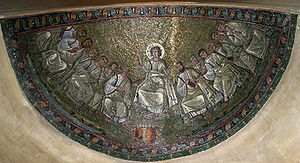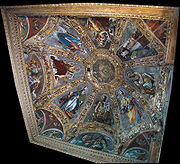
Basilica of San Lorenzo, Milan
Encyclopedia
The Basilica of Saint Lawrence is a church in Milan
, northern Italy
, dedicated to the Christian martyr
St. Lawrence.
., the Basilica of San Lorenzo was renovated and redecorated in the 16th century. It has however maintained the original Byzantine structure, with a dome and four towers resembling those of Constantinople
's Hagia Sofia. A recent detailed stratiographic study of the walls identified five phases of construction in antiquity from Theodosius I
to the early Lombard period
.
central-plan building, with a double-shell layout, consisting of an open central area (the inner shell) surrounded by an ambulatory
(the outer shell). The quatrefoil design is expressed in four exedra
e (semicircular recesses) of two stories, with five arches per exedra. As usual for the period, the interior had a matroneum
(balcony for female worshippers), now partially disappeared. Also the polychrome interior decoration is now missing. The dome was also rebuilt in Baroque
style after the original had crumbled down.

 Other chapels were added to the original edifice. Notable is the octagonal Capella di Sant'Aquilino (chapel of St. Aquilino), adjoining the main church to the south. The chapel, which may have originally been built as an imperial Roman mausoleum
Other chapels were added to the original edifice. Notable is the octagonal Capella di Sant'Aquilino (chapel of St. Aquilino), adjoining the main church to the south. The chapel, which may have originally been built as an imperial Roman mausoleum
, features important 4th century Paleochristian mosaics. Among the mosaics is included a formulaic depiction of Jesus, as "Christ the Lawgiver
" ("Traditio Legis" - "handing over the law") or possibly "Christ the teacher." Jesus is seated on a throne, flanked by a "school" of his Apostles, with a scroll box at his feet. The chapel was later dedicated to the martyr Saint Aquilino
of Milan (or Saint Aquilinus of Cologne), with his remains being housed in the chapel. A 17th century reliquary ark
for the saint was crafted by Lombardian architect Carlo Garavaglia (flourished 1634-1635). The fresco
The Rediscovery of Saint Aquilinus of Cologne's Corpse, by Carlo Urbino, decorates the wall behind the main altar in the Sant'Aquilino chapel.
"Mediolanum", dating from the 3rd century AD and probably belonging to the large baths built by the emperor Maximian
. They were carried in the current place when the basilica construction was finished.
The apse
area of the ancient basilica is now a park. Previously the area was occupied by a channel or a lake (probably with a port), while later it was used in public executions, one of which is recounted in Alessandro Manzoni
's Storia della Colonna Infame.
Milan
Milan is the second-largest city in Italy and the capital city of the region of Lombardy and of the province of Milan. The city proper has a population of about 1.3 million, while its urban area, roughly coinciding with its administrative province and the bordering Province of Monza and Brianza ,...
, northern Italy
Italy
Italy , officially the Italian Republic languages]] under the European Charter for Regional or Minority Languages. In each of these, Italy's official name is as follows:;;;;;;;;), is a unitary parliamentary republic in South-Central Europe. To the north it borders France, Switzerland, Austria and...
, dedicated to the Christian martyr
Martyr
A martyr is somebody who suffers persecution and death for refusing to renounce, or accept, a belief or cause, usually religious.-Meaning:...
St. Lawrence.
History
Various suggestions of its origin have been made, including a foundation in c.3704th century in architecture
See also:3rd century in architecture,other events of the 4th century,5th century in architecture and thearchitecture timeline.-Events:* 313 - Emperor Constantine issues the Edict of Milan, legislating toleration of Christian worship in the Roman Empire...
., the Basilica of San Lorenzo was renovated and redecorated in the 16th century. It has however maintained the original Byzantine structure, with a dome and four towers resembling those of Constantinople
Constantinople
Constantinople was the capital of the Roman, Eastern Roman, Byzantine, Latin, and Ottoman Empires. Throughout most of the Middle Ages, Constantinople was Europe's largest and wealthiest city.-Names:...
's Hagia Sofia. A recent detailed stratiographic study of the walls identified five phases of construction in antiquity from Theodosius I
Theodosius I
Theodosius I , also known as Theodosius the Great, was Roman Emperor from 379 to 395. Theodosius was the last emperor to rule over both the eastern and the western halves of the Roman Empire. During his reign, the Goths secured control of Illyricum after the Gothic War, establishing their homeland...
to the early Lombard period
Lombard architecture
The term Lombard achitecture refers to the architecture of the Kingdom of the Lombards in Italy, which lasted from 568 to 774 and which was commissioned by Lombard king and dukes....
.
Interior
The church is a quatrefoilQuatrefoil
The word quatrefoil etymologically means "four leaves", and applies to general four-lobed shapes in various contexts.-In heraldry:In heraldic terminology, a quatrefoil is a representation of a flower with four petals, or a leaf with four leaflets . It is sometimes shown "slipped", i.e. with an...
central-plan building, with a double-shell layout, consisting of an open central area (the inner shell) surrounded by an ambulatory
Ambulatory
The ambulatory is the covered passage around a cloister. The term is sometimes applied to the procession way around the east end of a cathedral or large church and behind the high altar....
(the outer shell). The quatrefoil design is expressed in four exedra
Exedra
In architecture, an exedra is a semicircular recess or plinth, often crowned by a semi-dome, which is sometimes set into a building's facade. The original Greek sense was applied to a room that opened onto a stoa, ringed with curved high-backed stone benches, a suitable place for a philosophical...
e (semicircular recesses) of two stories, with five arches per exedra. As usual for the period, the interior had a matroneum
Matroneum
A matroneum in architecture is a gallery on the interior of a building, originally intended to accommodate women ....
(balcony for female worshippers), now partially disappeared. Also the polychrome interior decoration is now missing. The dome was also rebuilt in Baroque
Baroque
The Baroque is a period and the style that used exaggerated motion and clear, easily interpreted detail to produce drama, tension, exuberance, and grandeur in sculpture, painting, literature, dance, and music...
style after the original had crumbled down.
Chapel of Saint Aquilino


Mausoleum
A mausoleum is an external free-standing building constructed as a monument enclosing the interment space or burial chamber of a deceased person or persons. A monument without the interment is a cenotaph. A mausoleum may be considered a type of tomb or the tomb may be considered to be within the...
, features important 4th century Paleochristian mosaics. Among the mosaics is included a formulaic depiction of Jesus, as "Christ the Lawgiver
Christ in Majesty
Christ in Majesty, or Christ in Glory, in Latin Majestas Domini, is the Western Christian image of Christ seated on a throne as ruler of the world, always seen frontally in the centre of the composition, and often flanked by other sacred figures, whose membership changes over time and according to...
" ("Traditio Legis" - "handing over the law") or possibly "Christ the teacher." Jesus is seated on a throne, flanked by a "school" of his Apostles, with a scroll box at his feet. The chapel was later dedicated to the martyr Saint Aquilino
Aquilinus of Milan
Saint Aquilinus of Milan , also known as Aquilinus of Cologne , is venerated as a martyr by the Catholic Church.He should not be confused with another Aquilinus, who was killed during the reign of the Arian Vandal king Hunneric in 484. This 5th century Aquilinus was killed with Eugene, Geminus,...
of Milan (or Saint Aquilinus of Cologne), with his remains being housed in the chapel. A 17th century reliquary ark
Reliquary
A reliquary is a container for relics. These may be the physical remains of saints, such as bones, pieces of clothing, or some object associated with saints or other religious figures...
for the saint was crafted by Lombardian architect Carlo Garavaglia (flourished 1634-1635). The fresco
Fresco
Fresco is any of several related mural painting types, executed on plaster on walls or ceilings. The word fresco comes from the Greek word affresca which derives from the Latin word for "fresh". Frescoes first developed in the ancient world and continued to be popular through the Renaissance...
The Rediscovery of Saint Aquilinus of Cologne's Corpse, by Carlo Urbino, decorates the wall behind the main altar in the Sant'Aquilino chapel.
Colonne di San Lorenzo
The square facing the basilica features the so-called "Colonne di San Lorenzo" (Columns of St. Lawrence), one of the few remains of the RomanAncient Rome
Ancient Rome was a thriving civilization that grew on the Italian Peninsula as early as the 8th century BC. Located along the Mediterranean Sea and centered on the city of Rome, it expanded to one of the largest empires in the ancient world....
"Mediolanum", dating from the 3rd century AD and probably belonging to the large baths built by the emperor Maximian
Maximian
Maximian was Roman Emperor from 286 to 305. He was Caesar from 285 to 286, then Augustus from 286 to 305. He shared the latter title with his co-emperor and superior, Diocletian, whose political brain complemented Maximian's military brawn. Maximian established his residence at Trier but spent...
. They were carried in the current place when the basilica construction was finished.
The apse
Apse
In architecture, the apse is a semicircular recess covered with a hemispherical vault or semi-dome...
area of the ancient basilica is now a park. Previously the area was occupied by a channel or a lake (probably with a port), while later it was used in public executions, one of which is recounted in Alessandro Manzoni
Alessandro Manzoni
Alessandro Francesco Tommaso Manzoni was an Italian poet and novelist.He is famous for the novel The Betrothed , generally ranked among the masterpieces of world literature...
's Storia della Colonna Infame.
See also
- Roman architectureRoman architectureAncient Roman architecture adopted certain aspects of Ancient Greek architecture, creating a new architectural style. The Romans were indebted to their Etruscan neighbors and forefathers who supplied them with a wealth of knowledge essential for future architectural solutions, such as hydraulics...
- List of Roman domes

